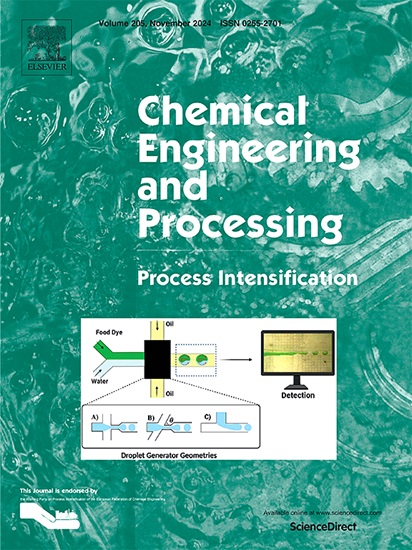Integrating vapor recompression heat pump into n-propyl acetate reactive distillation process for decarbonization and performance enhancement
IF 3.8
3区 工程技术
Q3 ENERGY & FUELS
Chemical Engineering and Processing - Process Intensification
Pub Date : 2025-07-14
DOI:10.1016/j.cep.2025.110447
引用次数: 0
Abstract
Vapor recompression technique (VRC) is one of the crucial strategies for process electrification and decarbonization within the New Industry 4.0 paradigm. This work explores the application of VRC, involving the novel intermediate reboiler (IR)-assisted VRC configuration, in the reactive distillation system for n-propyl acetate (PrAc) synthesis via transesterification of methyl acetate (MeAc) and n-propanol (PrOH). The conventional reactive distillation process (CRD), composed of a wide-boiling RD column and a sequential distillation column, is highly energy-intensive due to the existence of azeotropes. Process alternatives, incorporating double-effect distillation (DE), VRC and VRC-IR technologies, are proposed to save energy. In the optimization of the VRC-IR-assisted processes, the effects of crucial parameters, such as the side stream locations, the duty that associated with the IR and the compression ratio, on process intensification are discussed. The processes proposed are subsequently evaluated in terms of economic, environmental, and thermodynamic perspectives. Both VRC-assisted flowsheets demonstrate superior performance over the CRD and RD-DE cases. The RD-VRCIR-VRC, simultaneously intensifying VRC-IR and VRC in the two separate columns, emerges as the most efficient option, showcasing remarkable reductions of 48.16 % in TAC, 79.92 % in CO2 emissions and significant improvement of thermodynamic efficiency by 92.79 % compared with the CRD design.

将蒸汽再压缩热泵集成到醋酸正丙酯反应精馏过程中,实现脱碳和性能提升
蒸汽再压缩技术(VRC)是新工业4.0范式下过程电气化和脱碳的关键策略之一。本研究探讨了VRC在反应精馏系统中的应用,包括新型中间再沸器(IR)辅助VRC配置,通过乙酸甲酯(MeAc)和正丙醇(PrOH)的酯交换合成乙酸正丙酯(PrAc)。由于共沸物的存在,传统的反应精馏过程(CRD)是由一个宽沸点反应塔和一个顺序精馏塔组成的。提出了采用双效蒸馏(DE)、VRC和VRC- ir技术的工艺替代方案,以节省能源。在vrc -IR辅助工艺优化中,讨论了侧流位置、与IR相关的负荷和压缩比等关键参数对工艺强化的影响。提出的过程随后在经济,环境和热力学方面进行评估。与CRD和RD-DE案例相比,这两种vrc辅助流程都表现出了优越的性能。与CRD设计相比,rd - vrcr -VRC同时强化VRC- ir和VRC两列,是最有效的选择,其TAC显著降低48.16%,CO2排放量显著降低79.92%,热力学效率显著提高92.79%。
本文章由计算机程序翻译,如有差异,请以英文原文为准。
求助全文
约1分钟内获得全文
求助全文
来源期刊
CiteScore
7.80
自引率
9.30%
发文量
408
审稿时长
49 days
期刊介绍:
Chemical Engineering and Processing: Process Intensification is intended for practicing researchers in industry and academia, working in the field of Process Engineering and related to the subject of Process Intensification.Articles published in the Journal demonstrate how novel discoveries, developments and theories in the field of Process Engineering and in particular Process Intensification may be used for analysis and design of innovative equipment and processing methods with substantially improved sustainability, efficiency and environmental performance.

 求助内容:
求助内容: 应助结果提醒方式:
应助结果提醒方式:


